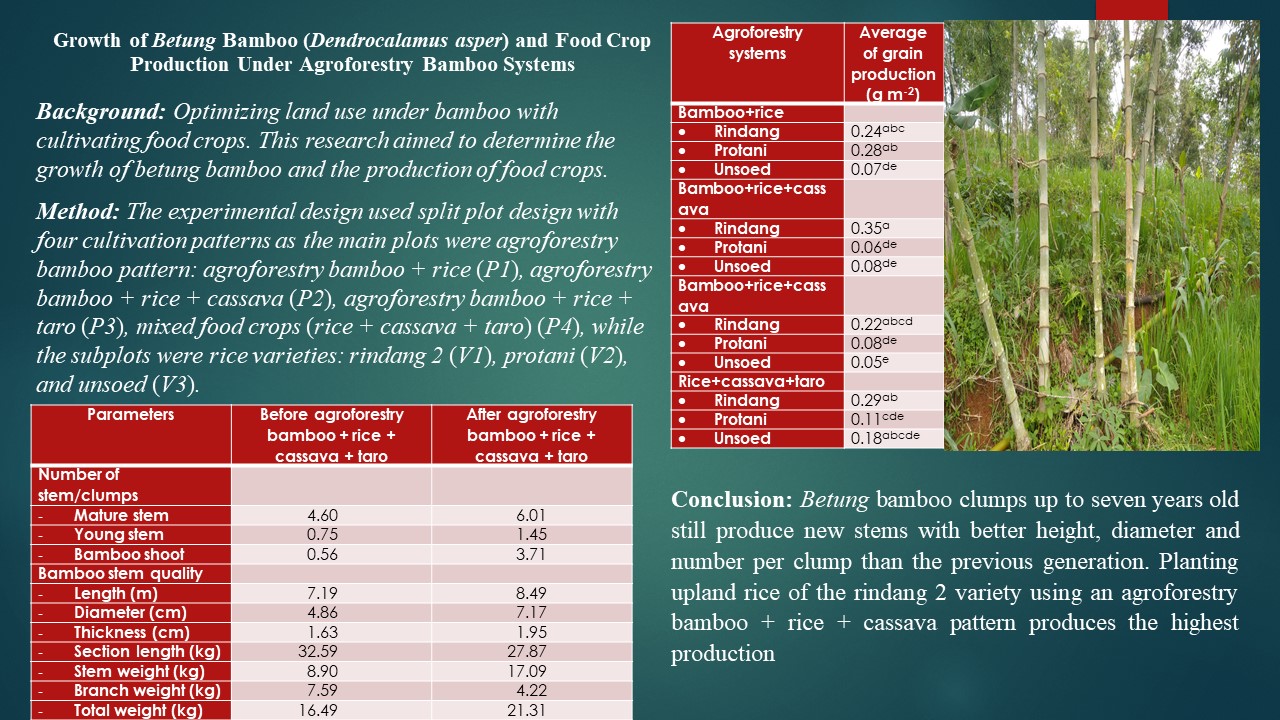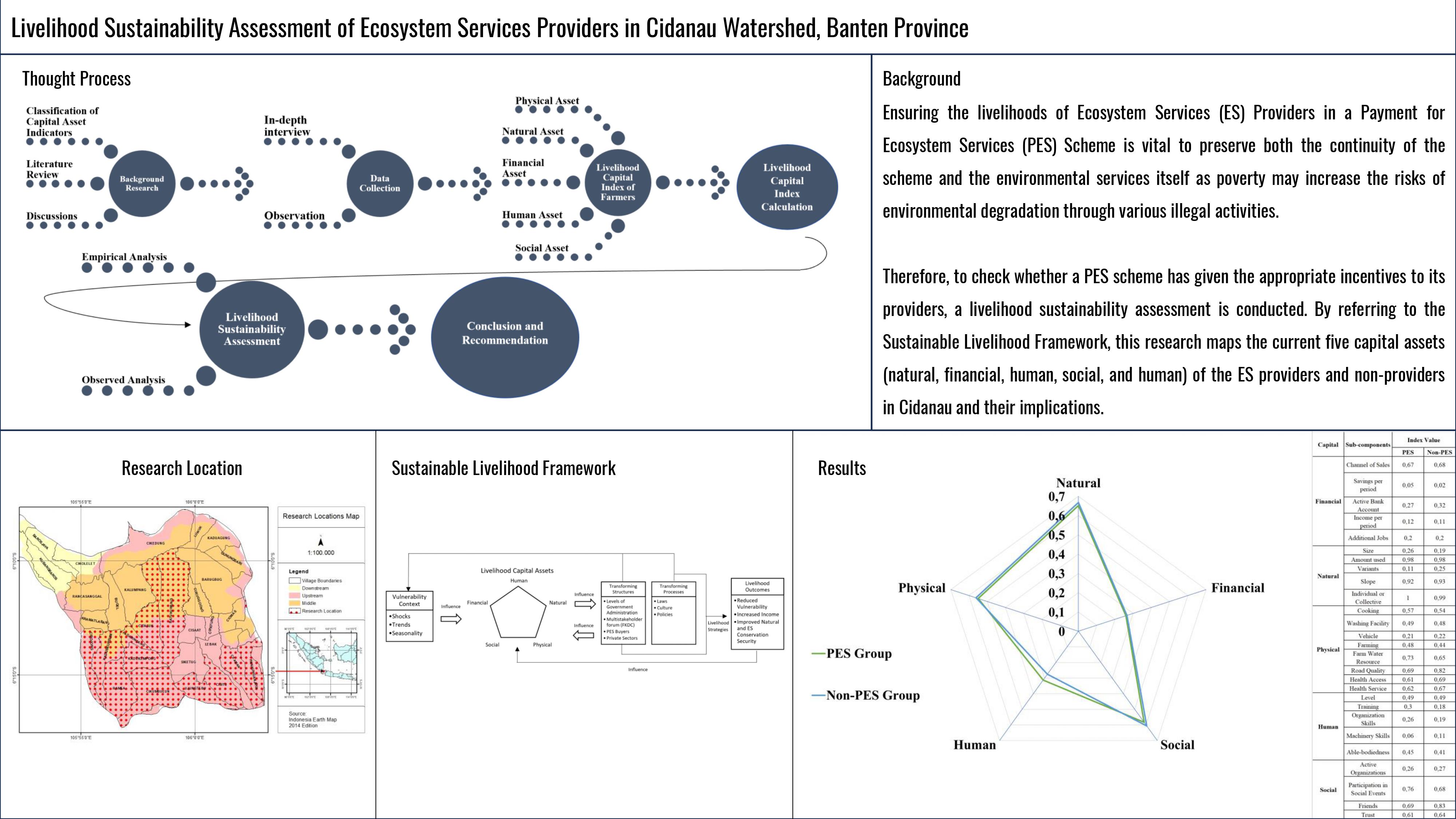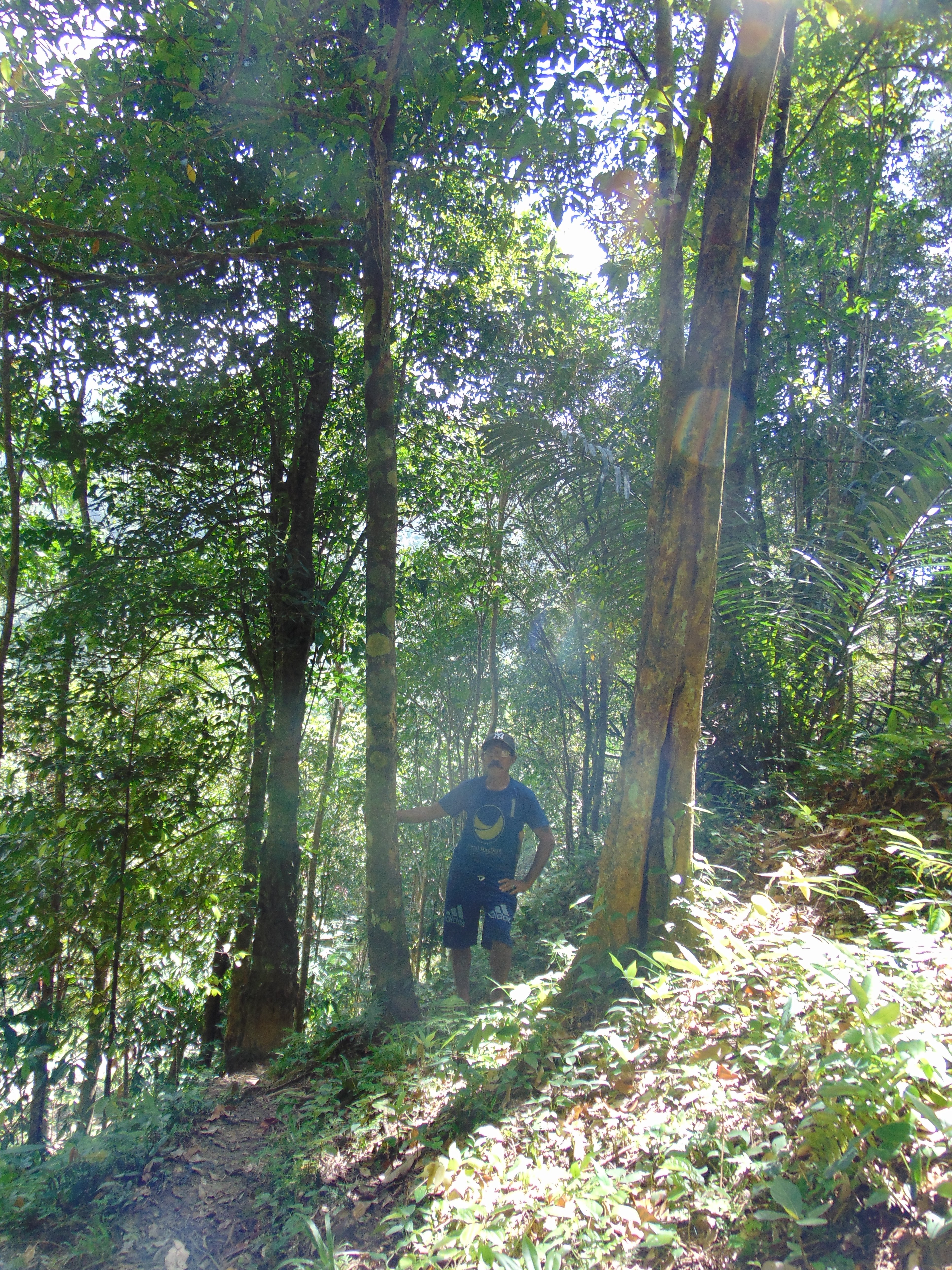Visual Evaluation of Soil Structure (VESS) Method to Assess Soil Properties of Agroforestry System in Pangalengan, West Java
Abstract
Agroforestry is an alternative land use that not only provides benefits in economic aspects, but also in ecological aspects including improving soil quality. This research aims to evaluate the physical quality of soil in various types of land use, including agroforestry systems and evaluate the efficiency of the VESS method in determining soil physical quality. This study uses the VESS method to analyze soil quality in six land uses in Pangalengan, West Java (i.e. agroforestry, forest, tea plantations, coffee plantations, agriculture cultivation, and abandoned land). It used The VESS method because it has been widely applied in many countries, but has never been applied in Indonesia. Soil property parameters (BD, soil porosity, soil permeability, and SOC) were measured to correlate with the VESS score. VESS score ranged from 1 (good soil quality) to 5 (poor soil quality). The VESS score for each land type ranged from Sq 1.3–4.33. The soil quality in agroforestry (Sq 1.89–2.04) is not much different from natural forest (Sq 1.3). The VESS score has strong correlation (r) with soil property parameters (BD = 0.97, soil porosity = -0.97, soil permeability = -0.83, SOC = -0.94). A Strong correlation value indicates that the VESS method can be used to analyze soil quality.
References
Aprianis, Y. (2011). Produksi dan laju dekomposisi Acacia crassicarpa A. Cunn. di PT. ARARA ABADI. Tekno Hutan Tanaman, 4(1), 41–47.
Arief, A. (2005). Hutan dan kehutanan. Jakarta: Kanisius.
Ball, B. C., Batey, T., & Munkholm, L. J. (2007). Field assessment of soil structural quality-a development of the Peerlkamp test. Soil Use and Management, 23, 329–337. https://doi.org/10.1111/j.1473-2743.2007.00102.x
Ball, B. C., Guimaraes, R. M. L., Cloy, J. M., Hargreaves, P. R., Shepherd, G., & McKenzie, B. M. (2016). Visual soil evaluation: A summary of some applications and potential developments for agriculture. Soil and Tillage Research, 210. https://doi.org/10.1016/j.still.2016.07.006
Ball, B. C., Hargreaves, P. R., & Watson, C. A. (2018). A framework of connections between and people can help improve sustainability of the food system and soil functions. Ambio, 47, 269–283. https://doi.org/10.1007/s13280-017-0965-z
Batey, T. (2000). Soil profile description and evaluation. In K. A. Smith, & C. E. Mullins (Eds.), Soil, and environmental analysis physical methods (pp. 595–628). New York: Marcell Dekker.
Batey, T. (2009). Soil compaction and soil management. Soil Use and Management, 25, 335–345. https://doi.org/10.1111/j.1475-2743.2009.00236.x
Bodner, G., Leitner, D., & Kaul, H. P. (2014). Coarse and fine root plants affect pore size distributions differently. Plant Soil, 380, 133–151. https://doi.org/10.1007/s11104-014-2079-8
Bottinelli, N., Jouquet, P., Capowiez, Y., Podwojewski, P., & Grimaldi, M. (2015). Why is the influence of soil macrofauna on soil structure only considered by soil ecologist? Soil and Tillage Research, 146, 118–124. https://doi.org/10.1016/j.still.2014.01.007
Cherubin, M. R., Karlen, D. L., Cerii, E. P., Franco, L. C., Tormena, C. A., Davies, A. C., & Cerri, C. C. (2016a). Soil quality indexing strategies for evaluating sugarcane expansion in Brazil. Plos One, 11(3), 126. https://doi.org/10.1371/journal.pone.0150860
Cherubin, M. R., Karlen, D. L., Cerri, E. P., Franco, L. C., Tormena, C. A., Davies, A. C., & Cerri, C. C. (2016b). Soil physical quality response to surgacane expansion in Brazil. Geoderma, 267, 156–168. https://doi.org/10.1016/j.geoderma.2016.01.004
Cherubin, M. R., Franco, L. C., Guimaraes, M. L., Tormena, C. A., Cerri, E. P., Karlen, D., & Cerri, C. C. (2017). Assessing soil structural quality under Brazilian sugarcane expansion areas using visual evaluation of soil structure (VESS). Soil and Tillage Research, 173, 64–74. https://doi.org/10.1016/j.still.2016.05.004
Cherubin, M. R., Bermeo-Chavaro, J. P., & Olaya-Silva, A. M. (2019). Agroforestry systems improve soil physical quality in Northwestern Colombian Amazon. Agroforestry System Journals, 93, 1741–1753. https://doi.org/10.1007/s10457-018-0282-y
Cui, J., Askari, M. S., & Holden, N. M. (2014). Visual evaluation of soil structure under grassland management. Soil Use and Management, 30, 129–138. https://doi.org/10.1111/sum.12100
Dollinger, J., & Jose, S. (2018). Agroforestry for soil health. Agroforestry System Journals, 92, 213–219. https://doi.org/10.1007/s10457-018-0223-9
Franco, H. H. S., Guimaraes, R. M. L., Tormena, C. A., Charubin, M. R., & Favilla, H. S. (2019). Global applications of the visual evaluation of soil structure method: A systematic review and meta-analysis. Soil and Tillage Research, 190, 61–69. https://doi.org/10.1016/j.still.2019.01.002
Freitas, M. A., Masseli, G. S., Marques, S., & Costa, F. (2017). Protocol for using the forest densiometer in RAPELD plots. Brazil: PPBio.
Gao, W., Hodgkinson, L., Jin, K., Watts, C. W., Ashton, R. W., Shen, J., ..., & Whalley, W. R. (2016). Deep roots and soil structure. Plant, Cell, and Environment, 39, 1662–1668. https://doi.org/10.1111/pce.12684
Ghezzehei, T. A. (2012). Soil structure. Merced: University of California.
Giarola, N. F. B., Da Silva, A. P., Tormena, C. A., Guimaraes, R. M. L., & Ball, B. C. (2013). On the visual of soil structure: The Brazilian experience in oxisols under no-tillage. Soil and Tillage Research, 127, 60–64. https://doi.org/10.1016/j.still.2012.03.004
Gregorich, E. G., Beare, M. H., McKim, U. F., & Skjemstad, J. O. (2006). Chemical and biological characteristics of physically uncomplexed organic matter. Soil Science Society of America Journal, 70, 975–985. https://doi.org/10.2136/sssaj2005.0116
Guimaraes, R. M. L., Ball, B. C., & Tormena, C. A. (2011). Improvements in the visual of soil structure. Soil Use and Management, 27, 395–403. https://doi.org/10.1111/j.1475-2743.2011.00354.x
Guimaraes, R. M. L., Ball, B. C., Tormena, C. A., Giarola, N. F., & Da Silva P. A. (2013). Relating visual evaluation of soil structure to other physical properties in soils of contrasting texture and management. Soil and Tillage Research, 127, 92–99. https://doi.org/10.1016/j.still.2012.01.020
Guimaraes, R. M. L., Junior, A. F. N., Silva, W. G., Rogers, C. D., Ball, B. C., Montes, C. R., & Pereira, B. F. F. (2016). The merits of the visual evaluation of soil structure method (VESS) for assessing soil physical quality in the remote, undeveloped regions of the Amazon basin. Soil and Tillage Research, 173, 75–82. https://doi.org/10.1016/j.still.2016.10.014
Guimaraes, R. M. L., Lamande, M., Munkholm, L. J., Ball, B. C., & Keller, T. (2017). Opportunities and future directions for visual soil evaluation methods in soil structure research. Soil and Tillage Research, 173, 104–113. https://doi.org/10.1016/j.still.2017.01.016
Istomo, Wasis, B., & Prihatiningtyas E. (2011). Pengaruh agroforestri jarak pagar (Jatropha curcas Linn.) terhadap produktivitas lahan dan kualitas lingkungan di areal Perum Perhutani KPH Bogor. Jurnal Silvikultur Tropika, 3(1), 113–118.
Johannes, A., Weisskopf, P., Schulin, R., & Boivin, P. (2016). To what extent do physical measurements match with visual evaluation of soil structure? Soil and Tillage Research, 173, 24–32. https://doi.org/10.1016/j.still.2016.06.001
Llado, S., Mondejar, R. L., & Baldrain, P. (2018). Drivers of microbial community structure in forest soils. Applied Microbiology and Biotechnology, 102, 43–31. https://doi.org/10.1007/s00253-018-8950-4
Misra, P. K. (2011). Soil fertility management in agroforestry system. International Journal of Biotechnology and Biochemistry, 7(5), 637–644.
Moncada, M. P., Gabriels, D., Lobo D., Rey, J. C., & Cornelis, W. M. (2014). Visual assessment of soil structural quality in tropical soils. Soil and Tillage research, 139, 8–18. https://doi.org/10.1016/j.still.2014.01.002
Paiva, I. A. D., Rita, Y. L., & Polizeli, K. M. C. (2020). Knowledge and use of visual soil structure assessment methods in Brazil – A survey. Soil and Tillage Research, 204, 104704. https://doi.org/10.1016/j.still.2020.104704
Prasetya, B., Prijono, S., & Widjiawanti, Y. (2012). Vegetasi pohon hutan memperbaiki kualitas tanah andisol-Ngabab. Indonesian Green Technology Journal, 1(1), 16.
Putinella, J. A. (2014). Perubahan distribusi pori tanah regosol akibat pemberian kompos ela sagu dan pupuk organik cair. Buana Sains, 14(2), 123–129.
Rabot, E., Wiesmeier, M., Schluter, S., & Vogel, H. J. (2018). Soil strucuture as an indicator of soil functions: A review. Geoderma, 314, 122–137. https://doi.org/10.1016/j.geoderma.2017.11.009
Raj, A., Jhariya, M. K., Toppo, P., & Oraon, P. R. (2017). Role of agroforestry in nutrient cycling. KISAN WORLD, 44(7), 38–40.
Rahmayuni, & Rosneti. (2017). Kajian beberapa sifat fisika tanah pada tiga penggunaan lahan di Bukit Batabuh. Jurnal Agrosains dan Teknologi, 2(1), 1–11.
Sandrawati, A., Setiawan, A., & Kesumah, G. (2016). Pengaruh kelas kemiringan lereng dan penggunaan lahan terhadap sifat fisik tanah di Kawasan Penyangga Waduk Cirata Kecamatan Cipeundeuy Kabupaten Bandung Barat. Soilrens, 14(10), 114–128.
Schumacher, T. E. & Riedell, W. E. (2008). Soil structure examined. Washington: Science.
Setyowati, G. L. (2007). Sifat fisik tanah dan kemampuan tanah meresapkan air pada lahan hutan, sawah, dan pemukiman. Jurnal Geografi, 4(2), 114–128.
Silva, G. L., Lima, H. V., Campanha, M. M., Gilkes, R. J., & Oliveira, T. S. (2011). Soil physical quality of luvisols under agroforestry, natural vegetation, and conventional crop management systems in the Brazilian semi-arid region. Geoderma, 167, 61–70. https://doi.org/10.1016/j.geoderma.2011.09.009
Six, J., Bossuyt, H., Degryze, S., & Denef, K. (2004). A history of research on the link between (micro)aggregates, soil biota, and soil organic matter dynamics. Soil & Tillage, 79, 731. https://doi.org/10.1016/j.still.2004.03.008
Stocker, C. M., Bamberg, A. L., Stumpf, L., Monteiro, A. B., Cardoso, J. H., & Lima, A. C. R. (2019). Short-term soil physical quality improvements promoted by an agroforestry system. Agroforestry Systems Journals, 94, 2053–2064. https://doi.org/10.1007/s10457-020-00524-3
Suarsana, I. W., Merit, I. N., & Adnyana, I. W. S. (2016). Prediksi erosi, klasifikasi kemampuan lahan dan arahan penggunaan lahan di Kecamatan Baturiti, Kabupaten Tabanan, Provinsi Bali. ECOTROPHIC, 10(2), 148–158.
Sun, Y., Luo, C., Jiang, L., Song, M., Zhang, D., Li, J., Li, Y., Ostle, N. J., & Zhang, G. (2020). Land-use changes alter soil bacterial composition and diversity in tropical forest soil in China. Science of the Total Environment, 712, 210. https://doi.org/10.1016/j.scitotenv.2020.136526
Suryani, E. & Dariah, A. (2012). Peningkatan produktivitas tanah melalui sistem agroforestri. Jurnal Sumberdaya Lahan, 6(2), 101–109.
Susanti, P. D. & Halwany, W. (2017). Dekomposisi serasah dan keanekaragaman makrofauna tanah pada hutan tanaman industri nyawai (Ficus variegate. Blume). Jurnal Ilmu Kehutanan, 2, 212–223.
Tolaka, W., Wardah, & Rahmawati. (2013). Sifat fisik tanah pada hutan primer, agroforestri, dan kebun kakao di Subdas Wera Saluopa Desa Leboni Kecamatan Pamona Puselemba Kabupaten Poso. Warta Rimba, 1(1), 1–8.
Tormena, C. A., Karlen, D., Logsdon, S. D., & Cherubin, M. R. (2016). Visual soil structure effects of tillage and corn stover harvest in Lowa. 2016. Soil Science Society of America Journal, 80, 720–726. https://doi.org/10.2136/sssaj2015.12.0425
Tuchtenhagen, I. K., De Lima, C. L. R., Bamberg, A. L., Guimaraes, R. M. L., & Moncada, M. P. (2017). Visual evaluation of the soil structure under different management systems in lowlands in Southern Brazil. Revista Brasileira de Ciencia do Solo, 42. https://doi.org/10.1590/18069657rbcs20170270
Undang, K., & Nurida, N. L. 2009. Perubahan agregat tanah pada ultisols Jasinga terdegradasi akibat pengolahan tanah dan pemberian bahan organik. Jurnal Tanah dan Iklim, 30, 37–46.
Yulnafatmawita, Naldo, R. A., & Rasyidin, A. (2008). Analisis sifat fisika ultisol tiga tahun setelah pemberian bahan organik segar di daerah Tropis Basah Sumbar. Jurnal Solum, 9(2), 91–97.
Authors

This work is licensed under a Creative Commons Attribution 4.0 International License.
Jurnal Manajemen Hutan Tropika is an open access journal which means that all contents is freely available without charge to the user or his/her institution. Users are allowed to read, download, copy, distribute, print, search, or link to the full texts of the articles in this journal without asking prior permission from the publisher or the author. This is in accordance with the Budapest Open Access Initiative (BOAI) definition of open access.







